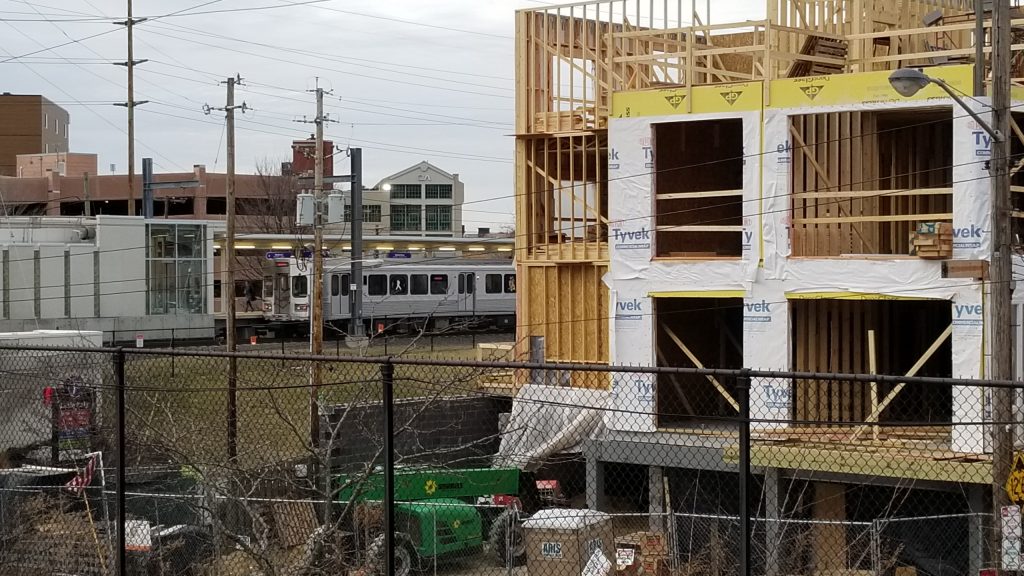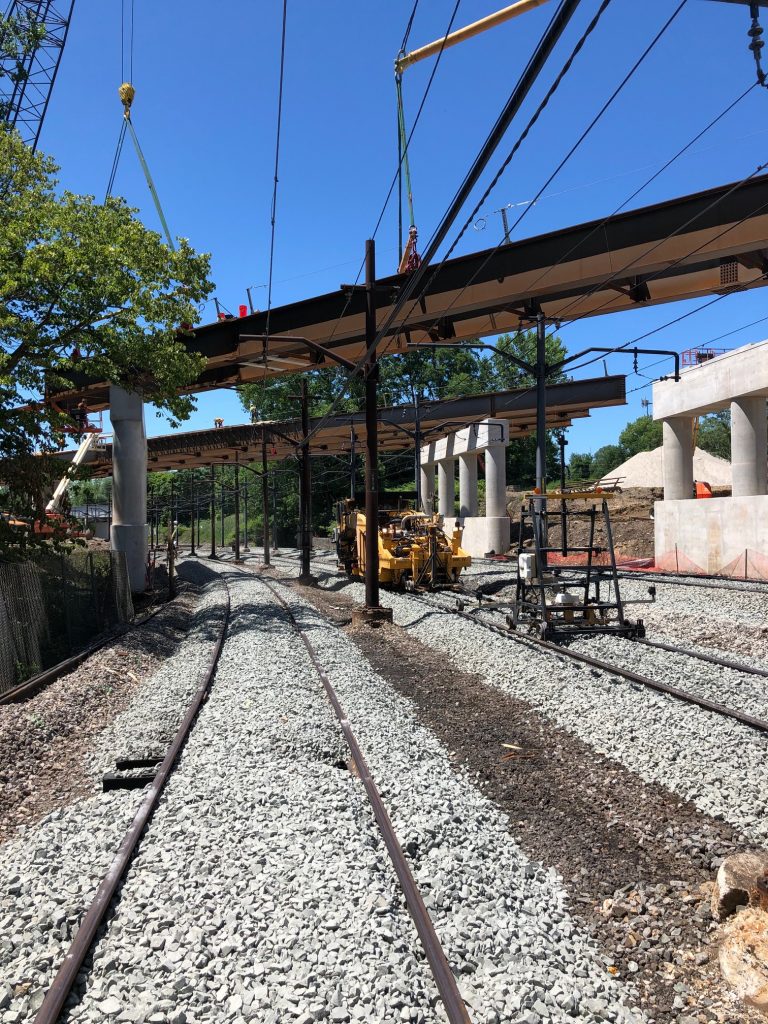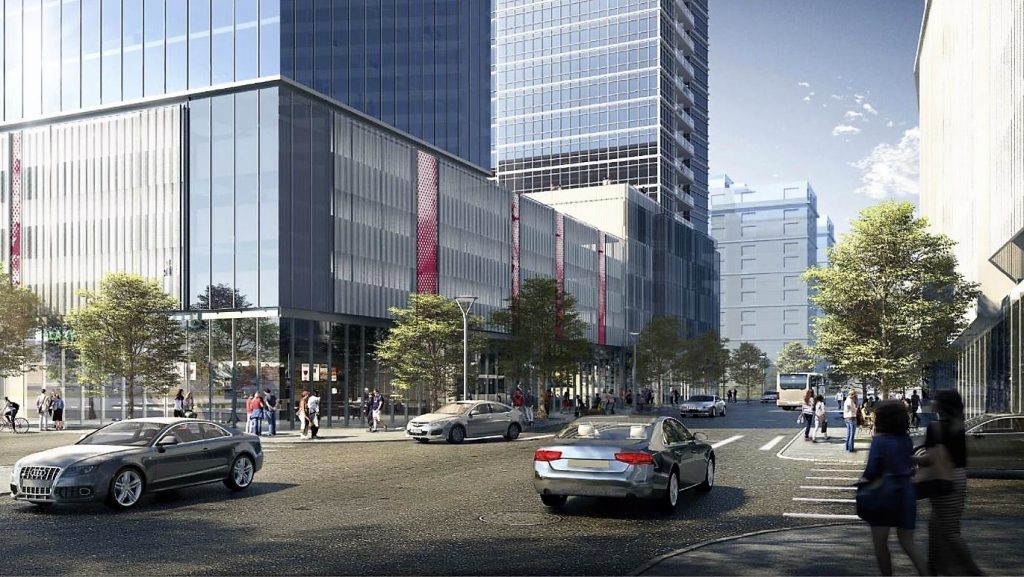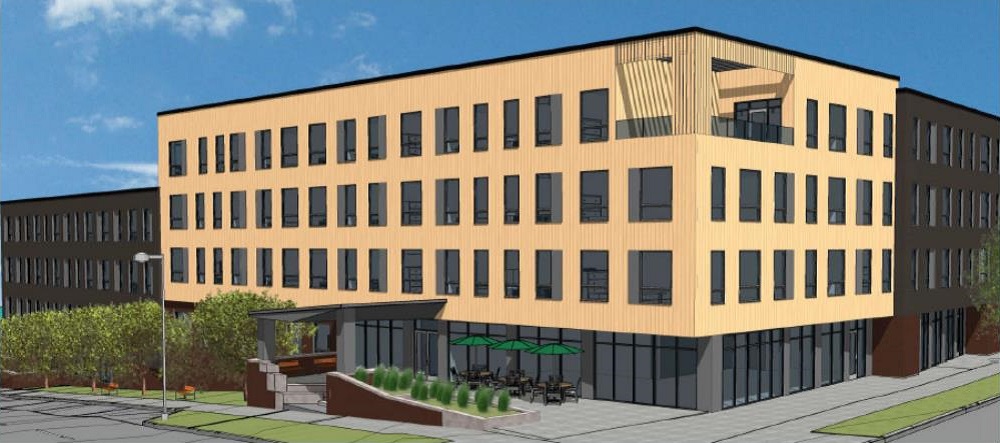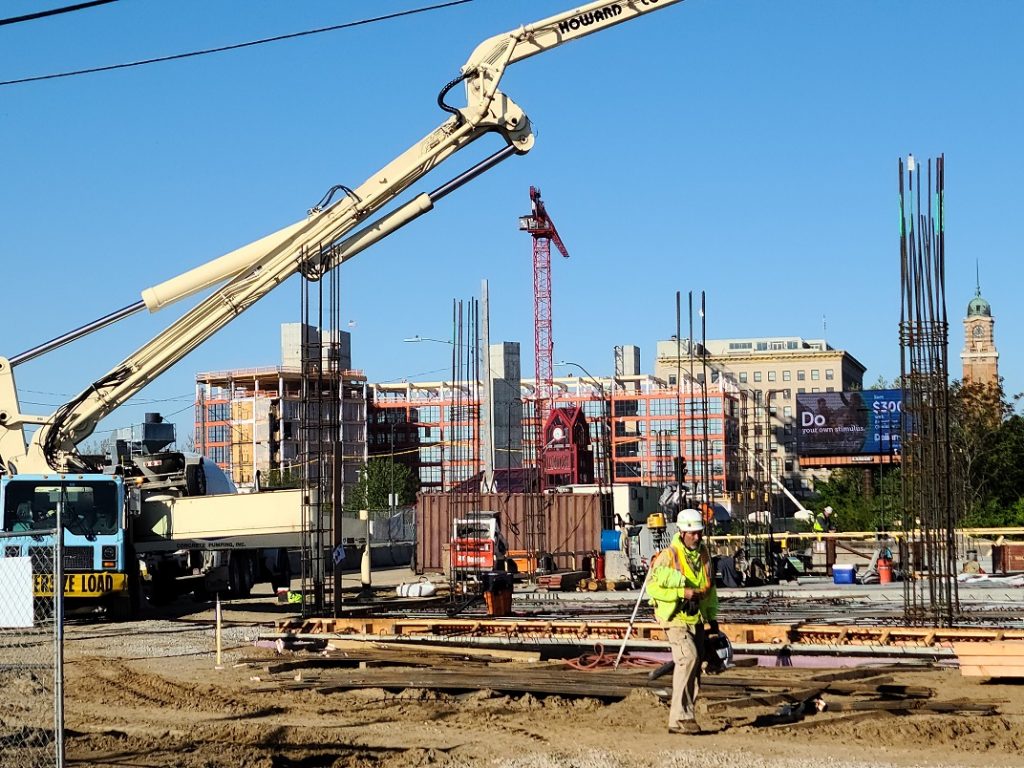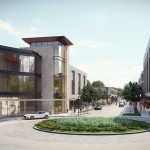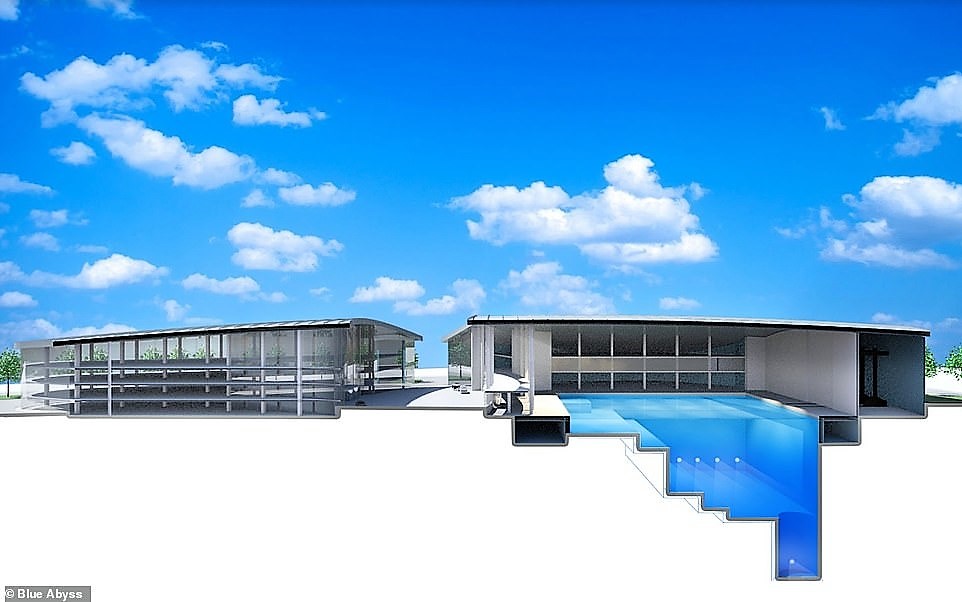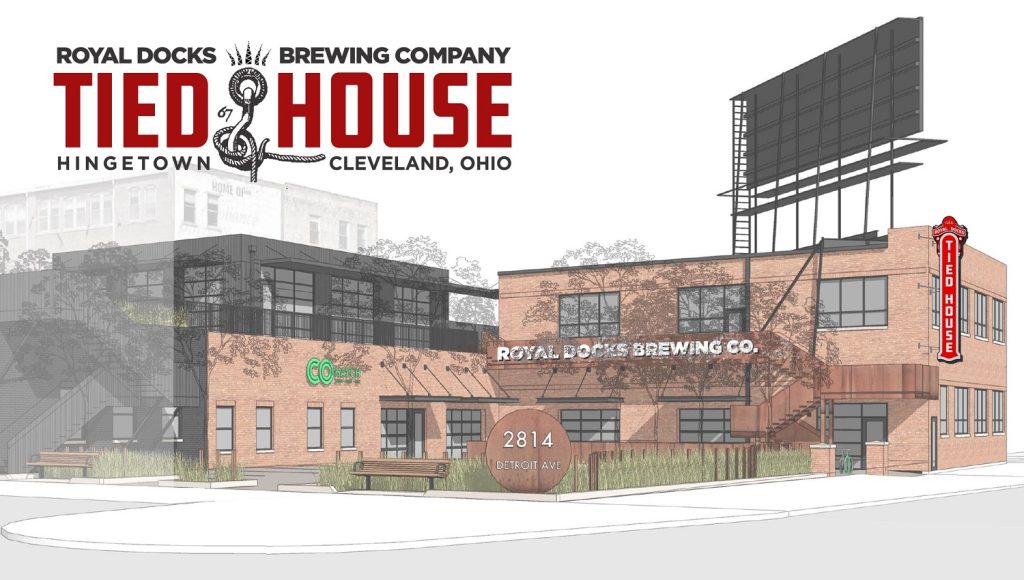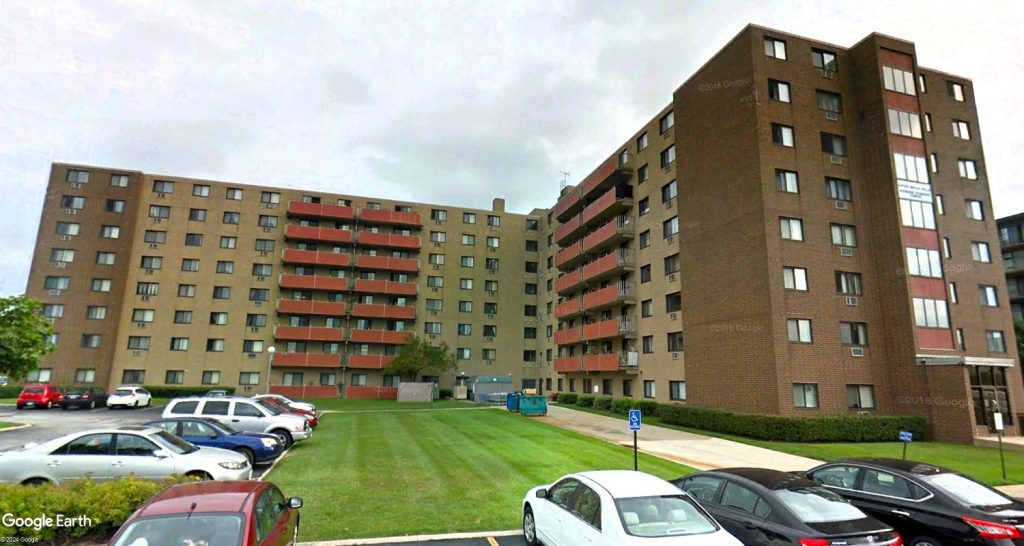Putting more residents, jobs and services next to existing rapid transit boosts Greater Cleveland’s quality of life. More real estate developers are recognizing the value to them from investing next to transit, as well as the growing number of public incentives to make those investments. In 2019, Mayfield Station Apartments was rising next to the new Little Italy-University Circle Red Line rail station. More developments like this are happening at more stations in Greater Cleveland (KJP).
CLICK ON IMAGES TO ENLARGE THEM
A few short steps away from a few rapid transit stations, thousands of housing units, millions of square feet of commercial space and a low-mileage lifestyle are rising in Greater Cleveland. And yet the work is just getting started.
There are many more developments coming to within steps of the region’s 90 rapid transit stations. In the concept of Transit Oriented Development (TOD), the more doorways that are put closer to a transit stop, the better.
It’s better for developers, the community and, of course, the transit agency. The developer/investor wins because structured parking in dense developments is costly to build and maintain, doesn’t produce enough revenue to offset the costs, requires significant public subsidy and/or increases rents on tenants.
It’s better for the community because all jobs, housing, shops and services are accessible to anyone regardless of whether they have a car. One in four Cleveland households have no car. For low-income households, car ownership often rivals housing as an expense.
The density of taxpayers plus utility/mail/public service customers, reduction of heat and stormwater runoff from smaller roofs and parking lots, plus less pollution and traffic from fewer vehicle-miles traveled by cars are all community benefits.
TOD is better for the transit operator because the more transit-proximate doorways, be they to a residence, office, shop or community service, intuitively means more potential riders. And rather than extending the transit system farther out from the city in a costly pursuit of sprawl and ridership, the jobs, residents and services are brought to the existing transit system.
Adding more doorways near transit is a tangible result of TOD’s overarching goal: “Successful TOD depends on access and density around the transit station,” says the U.S. Department of Transportation, which offers numerous financial incentives for TOD.
But just because a development is built near a transit stop doesn’t make it a TOD. If its design discourages pedestrian access by being set back from the street behind a big parking lot, has only one use in a low-density setting, and lacks doors and windows that don’t give pedestrians easy access or a sense of security, then it probably isn’t TOD.
There are far too many of these land uses around transit stops in Greater Cleveland, says the nonprofit rail and transit advocacy group All Aboard Ohio. They say the region needs more and larger TOD near rail stations. The absence of density and mixed uses around more stations is a major reason why Greater Cleveland Regional Transit Authority’s (GCRTA) rail system is one of the worst performing rail systems in the nation.
Meanwhile pro-business groups like the Greater Cleveland Partnership have yet to lead the region when it comes to TOD. Instead it has spoken more forcefully in urging GCRTA to expand outward to chase after jobs moving farther from the labor pool and into low-density settings where transit must travel long distances to capture fewer riders. It’s a high-cost, low-yield endeavor.
GCRTA’s rail system represents a multi-billion-dollar asset for the region. GCRTA is in the midst of a major capital improvement program, seeking to reduce its state-of-good-repair backlog from more than $600 million in unfunded projects. That backlog has meant speed limits on rail lines, aging trains that break down and electrical systems that fail.
In just five years, GCRTA has halved its backlog to $300 million by either making necessary capital improvements or by identifying funding for them. Rebuilt tracks, modernized electrical systems and new trains are going to arrive despite a recent hiccup. More federal funding for transit infrastructure is contained in President Joe Biden’s bipartisan infrastructure bill.
The Green and Blue lines linking Shaker Heights and downtown Cleveland are currently getting tracks rebuilt from the ground up and in affordable sections. The first section was rebuilt last year, from near East 55th Street to Buckeye-Woodhill Station for $10 million. This week, work started on rebuilding the portion from Woodhill to Shaker Square for $8 million. Construction will conclude in October.
Some of Ohio’s largest developments are rising next to GCRTA stations on its rail and bus rapid transit lines. Of those, only Sherwin-Williams’ new headquarters is larger than the Circle Square development north of Euclid Avenue and Stokes Boulevard in University Circle, directly served by GCRTA’s HealthLine bus rapid transit.
At just over 1 million square feet among all phases, this second downtown for Cleveland led by Midwest Development Partners is adding mixed uses of residential or offices over retail and neighborhood services.
Construction on the 24-story Artisan tower is well underway with work just getting started on the 11-story Library Lofts. Several more towers will follow, representing a total investment of more than $300 million.
And Sherwin-Williams’ new HQ downtown, whose first phase offers 1 million square feet in a 616-foot-tall tower, will bring another $300 million-plus investment. A second-phase tower could deliver an additional 300,000 square feet. Those towers will be just west of Public Square where all of Cleveland’s rail and bus rapid transit lines come together. More than one-third of Sherwin-Williams HQ employees commute by transit.
Two major developments are adding much-needed density within a few steps of GCRTA’s light-rail Blue Line — Woodhill Station in Cleveland and the Van Aken District in Shaker Heights. At GCRTA’s Buckeye-Woodhill Station, abandonment is being reversed. At the Warrensville-Van Aken Station, car-dominant land uses are being remedied.
Construction is underway by Marous Brothers and the Community Builders Inc. on the first phase of Woodhill Station — a roughly $40 million, 135,000-square-foot apartment building on the former site of the Buckeye-Woodland Elementary School, 9511 Buckeye Rd. The mixed-income, a 120-unit apartment building will offer 41 one-bedroom, 61 two-bedroom and 18 three-bedroom apartments.
Financing is also coming together for the next phase of Woodhill Station — a $25 million, 69-unit, mixed-income apartment building that will rise between the first phase and the northwest corner of Buckeye and Woodhill roads.
It will have a ground-floor retail/community space at the street corner to add street presence to the project. Together, the two buildings will place up to 300 new residents across Buckeye Road from a GCRTA light-rail station that was rehabilitated in 2013.
At the east end of the Blue Line, RMS Investment Group and its the Van Aken District are turning a tangle of roadways, post-war shopping plazas and their seas of surface parking into a walkable downtown for Shaker Heights. Pieces were already in place to create this downtown. Nearby is the 12-story Tower East office building and the 8-story Chelsea Condominiums.
Van Aken District’s first phase opened two years ago, bringing a mix of retail, restaurants, residential, offices and public spaces. The next phase, approved by the city in June, will bring 225 market-rate apartments in an 18-story tower connected to a new 15-story tower.
Construction on both towers is due to start in early 2022. So is a new GCRTA rail and bus station plus public realm improvements that will support additional development in the southeast part of the Van Aken District.
That kind of density is desperately needed around more GCRTA rail stations that can be the central hubs of each neighborhood. And each of those neighborhoods can be a 15 Minute City where nearly all of a resident’s daily needs, from working, shopping, education, health care and more can be accomplished within a 15 minute walk or bike trip.
One station that is seeing significant densification and diversification around it is the Red Line’s Ohio City station. With the West Side Market plus offices and other employers nearby, it is already a destination station. But it’s becoming a trip-origination station too, what with INTRO and Waterford Bluffs due to add up to 800 residents starting in 2022.
Within feet of the station, the first phase of Harbor Bay Real Estate Advisors’ INTRO will add 288 residential units and 35,000 square feet of commercial space. A second phase may soon follow, adding many more apartments.
In the other direction from the train station, Stoneleigh’s Waterford Bluffs will deliver another 241 apartments next year. Additional developments are planned, including MRN Ltd.’s conversion of the 237,000-square-foot Voss Building on West 25th Street into a mixed-use complex, plus new-construction residential on the west side of West 26th Street. MRN also plans a joint-development with GCRTA next to the rail station.
Between the Waterford Bluffs development in the foreground and the larger INTRO project in the background is the red clock tower of the Red Line’s Ohio City train station, seen at the base of the red construction tower crane. These and other developments will likely produce more accessibility to and from Greater Cleveland’s underutilized rail system (KJP).
One of the most active station-areas in the last five years has been the Little Italy-University Circle station which was built new for $15.6 million in 2015. It replaced a poorly sited and little-used station at Euclid-East 120th.
The new station’s ridership grew by more than 100 percent just in the first year. Since then, Centric, Random Road Lofts, La Collina and Mayfield Station Apartments representing an investment of more than $100 million have followed.
New public funding could help stimulate more development along rapid transit lines, especially on polluted former industrial sites called brownfields. Ohio is making $350 million available to clean up these properties and another $150 million to aid in structural demolitions and revitalization of sites that aren’t brownfields. Without these funds, developers and investors would be more likely to invest in duplicative communities at the urban fringe than reinvigorated ones closer in.
One of the most significant new public funding initiatives to support complex, large-scale developments in Ohio’s largest cities is the Transformational Mixed Use Development (TMUD) tax credit. Eligible real estate developments will have a construction cost of at least $50 million, involving a building at least 15 stories tall or more than 350,000 square feet of connected buildings. Up to $100 million per year over the next four years will be available to qualifying projects.
If more developments of scale are located along rapid transit corridors, they will allow Greater Cleveland’s to leverage more value from its existing infrastructure. That value includes linking more residents to accessible housing, jobs, shopping and services, reducing housing and transportation costs, while lessening costly car dependency, pollution and traffic thereby improving Greater Cleveland’s quality of life.
And the region is just starting to open the door to more TOD.
END

